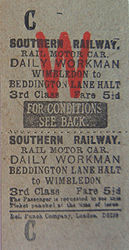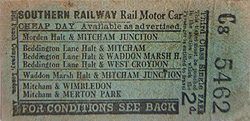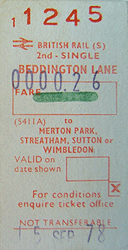|
Notes: Beddington station was on the Wimbledon - West Croydon line. The line opened on 22 October 1855 but the station is not mentioned in the original inspection report. The station was two miles from Beddington village so in January 1887 it was renamed Beddington Lane. It consisted of a single 200ft bi-directional platform on the 'up' side of the line. The platform could accommodate a maximum of three coaches. The station had a single-storey timber building incorporating waiting rooms and a gents' toilet at the west end.
Prior to 1877 there appears to have been no signal box and it is possible that there was just a ground frame controlling the level crossing; at the time this would have been all that was required. Sometime around 1877 a small cabin appeared on the platform, so it is possible the crossing frame, wherever it was located, was moved to the cabin further along the platform.
Beddington Lane became a block post in 1901 (a signal box at the end of a block section) and at some time circa 1890s a timber Saxby & Farmer box was erected adjacent to the level crossing. By 1901 the design of the box was somewhat outdated, suggesting that it might have been recovered from elsewhere.
A two-storey stationmaster's house was built to the rear of the platform in 1896. From early photographs (reproduced below) this appears to have replaced an earlier house behind the station building.
There has been little residential development in the area, even today, and passenger traffic was always light but freight traffic along the line was much heavier. A ballast siding was laid on the east side of the level crossing in 1901 and continued towards Waddon Marsh for 2 miles. In 1932 this served a Demolition and Construction Co, Croydon Cable Co, Edwards Construction Co and the Ministry of Mines Coal Dump. A second siding ran for half a mile from the level crossing to serve the British Portland Cement sidings as far as the junction of Alfriston Avenue and Dacre Avenue near Therapia Lane before merging back in to the main line; these were known as Tarfoid sidings. On 1 November 1918 Beddington Lane was downgraded to an unstaffed halt as an economy measure in WW1 and it was officially renamed Beddington Lane Halt in 1919.
 The original box was replaced by a larger timber structure on a brick base on 25 May 1930. As with the box at Waddon Marsh, this doubled-up as the ticket office for some time; tickets could also be bought from the guard. Beddington Lane Halt received BR totem signage in standard Gill Sans and a running-in board letters in Transport typeface. David Lawrence in British Rail Designed 1948-97 (Ian Allan, 2016) notes that ‘the Transport alphabet designed for British motorway signs by Jock Kinneir and Margaret Calvert was offered to British Railways too, resulting in its use on some totem and other signs in the late 1950s’, but its use appears to have been a uniquely Southern Region aberration. Gas lighting gave way to electric sometime between 1962 and 1967. The station reverted to Beddington Lane on 6 May 1969, when BR (SR) discontinued using the ‘Halt’ suffix for public stations, although all the station signs still showed Beddington Lane Halt until Corporate Identity signage was installed at some date between 22 December 1978 and 19 February 1979. The independent freight line between Beddington Lane and West Croydon was taken out of use from 1 February 1976 and from 14 September 1980 the signal box was only used to work the crossing gates. When the gates were replaced by automatic lifting barriers on 23 May 1982 the box was closed and it was demolished shortly afterwards. The wooden station building was demolished in the 1990s and replaced with a ‘bus’ shelter. The original box was replaced by a larger timber structure on a brick base on 25 May 1930. As with the box at Waddon Marsh, this doubled-up as the ticket office for some time; tickets could also be bought from the guard. Beddington Lane Halt received BR totem signage in standard Gill Sans and a running-in board letters in Transport typeface. David Lawrence in British Rail Designed 1948-97 (Ian Allan, 2016) notes that ‘the Transport alphabet designed for British motorway signs by Jock Kinneir and Margaret Calvert was offered to British Railways too, resulting in its use on some totem and other signs in the late 1950s’, but its use appears to have been a uniquely Southern Region aberration. Gas lighting gave way to electric sometime between 1962 and 1967. The station reverted to Beddington Lane on 6 May 1969, when BR (SR) discontinued using the ‘Halt’ suffix for public stations, although all the station signs still showed Beddington Lane Halt until Corporate Identity signage was installed at some date between 22 December 1978 and 19 February 1979. The independent freight line between Beddington Lane and West Croydon was taken out of use from 1 February 1976 and from 14 September 1980 the signal box was only used to work the crossing gates. When the gates were replaced by automatic lifting barriers on 23 May 1982 the box was closed and it was demolished shortly afterwards. The wooden station building was demolished in the 1990s and replaced with a ‘bus’ shelter.
In the 1990s a large new industrial building was built on the south side of the line along with some industrial units to the rear of the platform. Until 1999 anyone without access to a car wishing to reach the industrial units on Beddington Lane or living in houses nearby was reliant on the railway for transport as the first bus service along the road did not start until that time when a private minibus service began. Today this is now a Transport for London bus route.
The track was lifted and the station demolished in the summer of 1998 and a new Beddington Lane tram stop was opened at the west end of the original station on 30 May 2000.
In the Croydon Advertiser on 20 August 1953, there is a fascinating story about the entire Pollards Hill Tenants’ Association travelling to Bognor Regis for the day.
On Sunday morning 600 people left their homes on the Pollards Hill housing estate at Mitcham. They walked across Mitcham Common in parties of 50 and were seen across the busy Croydon Road by a police patrol. On arrival at Beddington Lane Halt they boarded a special 12-coach train and set off for Bognor Regis. During the one and a half hour journey to Bognor Regis every one of the 363 children in the party was given a shilling. The shillings were carried to the train in a mysterious black bag by Mr W Stephens, the Pollards Hill Estate Tenants’ Association's treasurer. They had been supplied by an obliging gas company. A total of 3,500 half-price amusement tickets were also given to the children.
At Bognor Regis a tent was erected on the beach as a headquarters and over it flew a PHETA flag. Throughout the day two nurses from the Mitcham Red Cross detachment were on duty to treat minor casualties among the Mitcham party. Everyone had forgotten that the tide would come in, and the tent was saved at the last moment as the waves lapped up to the guy ropes just after lunch. Eventually the headquarters party was squeezed off the beach onto the promenade.
The people of Pollards Hill occupied a long stretch of the Bognor Regis seafront and before long the braver ones were occupying the sea. The remainder of them preferred sand castles, donkey rides or deck chairs and newspapers according to their age groups. After they had spent eight hours in the resort the Mitcham party left Bognor Regis at 6.28 pm.
The August bank holiday of 1950 saw more that 20,000 people arriving at Bognor Regis by train.
BRIEF HISTORY OF THE WIMBLEDON - WEST CROYDON LINE
Before the coming of the railways the River Wandle was very heavily industrialised with 38 water mills and factories along its short length between Wandsworth and Croydon. As the river was not navigable, the mill owners required a means of transport for their goods so the Surrey Iron Railway was built between Wandsworth and Croydon. This was the earliest public railway in the London area and the first railway to receive parliamentary sanction in 1801. The 4ft gauge double-track horse-drawn iron plateway was built by William Jessop and opened on 26 July 1803. The line was later extended south as the Croydon Merstham and Godstone Railway terminating at underground stone quarries at Merstham.
 The line was never profitable as much of the traffic from Croydon used the Croydon Canal which opened in 1809 terminating at a basin adjacent to the Surrey Iron Railway at what is now West Croydon station. After 1825 the company paid no dividend. Early in 1844 there was a proposal by the London & Brighton to use the former trackbed of the Surrey Iron Railway and the CM&GR to reach a new terminus at Waterloo Bridge from its existing Brighton line at Purley, and in August that year the London & South Western Railway took an option to buy the SIR track bed but neither scheme was proceeded with and the SIR was eventually dissolved on 3 August 1846 and the track bed reverted to agricultural use. The line was never profitable as much of the traffic from Croydon used the Croydon Canal which opened in 1809 terminating at a basin adjacent to the Surrey Iron Railway at what is now West Croydon station. After 1825 the company paid no dividend. Early in 1844 there was a proposal by the London & Brighton to use the former trackbed of the Surrey Iron Railway and the CM&GR to reach a new terminus at Waterloo Bridge from its existing Brighton line at Purley, and in August that year the London & South Western Railway took an option to buy the SIR track bed but neither scheme was proceeded with and the SIR was eventually dissolved on 3 August 1846 and the track bed reverted to agricultural use.

It was not long before there were further proposals promoted by local interests. One of these was the Mitcham & South Western Junction Railway running from Mitcham Green to the LSWR at Earlsfield. This was opposed by the LSWR but eventually an independent scheme to build a line from Wimbledon to Croydon was approved with the LSWR leasing the line between Wimbledon and Mitcham and the LBSCR leasing the remainder to a junction with its own line at West Croydon. The LSWR eventually pulled out of the scheme and the Wimbledon & Croydon Railway received its Act in 1853 with a provision for working arrangements with the LSWR.

The line was built by local Mitcham engineer George Parker Bidder and after two postponements to comply with Board of Trade requirements the line opened on 20 October 1855 with two intermediate stations at Mitcham and Beddington. Although sufficient land had been purchased for double track only single track was laid. The line followed the course of the Surrey Iron Railway from a point just west of Mitcham station to the site of the later Waddon Marsh Halt. There were no major engineering works with the line running on the level for much of its length requiring level crossings over seven public roads. A third intermediate station at Morden opened in March 1857
In a further Act in 1856 the LBSCR secured a 21-year lease to operate the line with authorisation to raise capital to double the track if required. However in 1857 with the prospect of LBSCR trains running into Wimbledon the LSWR revived their interest and obtained Parliamentary authority in 1857 for joint operation securing the Wimbledon - Mitcham section for the remainder of the lease on the understanding that the Brighton could continue to work into Wimbledon. In 1862 a joint committee was set up to manage the line which was later purchased outright from the W&CR by the LBSCR on 1st January 1866. The LSWR were offered a half share in the venture but declined, retaining an interest only in the section shared with their proposed Wimbledon - Tooting route.
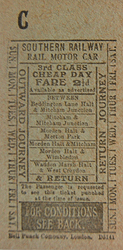 On 1 October 1868, the LBSCR opened their line from Peckham Rye to Sutton; this cut across Mitcham Common turning sharply to join the W&CR where a new shared station at Mitcham Junction was opened. Beyond the station the new line diverged to the south and on towards Sutton. On 1 October 1868, the LBSCR opened their line from Peckham Rye to Sutton; this cut across Mitcham Common turning sharply to join the W&CR where a new shared station at Mitcham Junction was opened. Beyond the station the new line diverged to the south and on towards Sutton.
The Tooting, Merton & Wimbledon Railway also opened on 1 October 1868 from Streatham Junction to Wimbledon, which was approached from two directions by lines diverging at Tooting Junction, one coming into the town from the north-east, the other from the south-east after forming a junction with the Wimbledon & Croydon at Merton. A station called Lower Merton was opened at the junction but this initially had platforms only on the Tooting line although a third platform was later added on the Croydon line opening on 1 November 1870.
The Croydon line saw few changes before World War I with 12 trains a day in each direction and one rail-motor working. The line between Mitcham and Mitcham Junction had been doubled in March 1879, probably to facilitate the working of goods trains to and from the yard at Mitcham which was the only public goods depot on the line. Passenger traffic between Wimbledon and Croydon was very light; Merton Park was the only station that saw even a small increase in residential travel as the area was developed. There was virtually no other housing development along the line before 1914.
 Freight traffic gradually assumed more importance between Mitcham and Croydon where a number of sidings were built of which the most noteworthy was the ‘Waddon Marsh New Siding’ serving Waddon Flour Mills on the north bank of the Wandle, a single line of almost a mile running due south from the Croydon end of Beddington Lane. Near this junction, sidings served gravel pits on both sides of the line, those on the south later rearranged for the British Portland Cement Works, the others for a permanent way depot. Another siding, on the north side, a little nearer Croydon entered a brewery and was followed by another into the Croydon Gas, Commercial & Coke Company’s works at Waddon Marsh, west of the line. After 1920, these works expanded to the east side, requiring another set of sidings. Also on that side was Croydon Power Station, rail-served from about 1925 and with its own internal system. In 1948-50 a second and very large power station (Croydon B) was built on the west side of the W&CR north of the gasworks; this, too, had a large complex of sidings
During WW1 push-and-pull sets of two side-gangway coaches and Stroudley 0-4-2T were introduced as a wartime economy from 1 November 1918. These were manned by conductor guards who issued tickets to those boarding at what were now unstaffed halts at Merton Park (formerly Lower Merton), Morden and Beddington Lane. The booking office at Merton Park reopened in 1923 but Beddington Lane and Morden Road remained unstaffed.
 With the opening of the Northern Line extension to Morden on 13 September 1926 passenger revenue form Merton Park, Morden Road (formerly Morden) and Mitcham declined rapidly although through journeys continued to attract a steady patronage. In 1927 there were 14 push-and-pull workings between Wimbledon and West Croydon, one extended to Crystal Palace Low Level, two from Wimbledon to Sutton via Mitcham Junction, and another from Mitcham to Crystal Palace Low Level; a similar service worked down. The line maintained healthy freight traffic, especially around Croydon and Waddon Marsh. In 1930, during the building of the London County Council's 825-acre St Helier housing estate, the contractors laid an extensive temporary network of flat-bottom rails on cinder ballast to carry materials as required to the building sites, this being connected to the W&CR through a siding at Mitcham goods yard. This rail network which included a 30ft bridge over the River Wandle was operated by six locomotives shedded at a depot about a mile south of Mitcham. It was one of the last examples in southern England of a major public works contract relying on rail-delivered materials which were carried to site over specially-laid lines. The W&CR also handled the Southern’s own needs for its permanent way depot on the north side of the line near Beddington Lane and for the civil engineer’s depot next to the goods yard at Mitcham. With the opening of the Northern Line extension to Morden on 13 September 1926 passenger revenue form Merton Park, Morden Road (formerly Morden) and Mitcham declined rapidly although through journeys continued to attract a steady patronage. In 1927 there were 14 push-and-pull workings between Wimbledon and West Croydon, one extended to Crystal Palace Low Level, two from Wimbledon to Sutton via Mitcham Junction, and another from Mitcham to Crystal Palace Low Level; a similar service worked down. The line maintained healthy freight traffic, especially around Croydon and Waddon Marsh. In 1930, during the building of the London County Council's 825-acre St Helier housing estate, the contractors laid an extensive temporary network of flat-bottom rails on cinder ballast to carry materials as required to the building sites, this being connected to the W&CR through a siding at Mitcham goods yard. This rail network which included a 30ft bridge over the River Wandle was operated by six locomotives shedded at a depot about a mile south of Mitcham. It was one of the last examples in southern England of a major public works contract relying on rail-delivered materials which were carried to site over specially-laid lines. The W&CR also handled the Southern’s own needs for its permanent way depot on the north side of the line near Beddington Lane and for the civil engineer’s depot next to the goods yard at Mitcham.
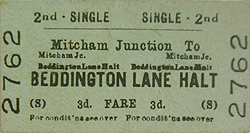
Electrification of the Southern's suburban railway network was nearing completion by 1928 and approval was given for electrification of the W&CR on 7 July that year. With the increased frequency of trains after electrification of the line the Southern had to consider how this would affect the handling of the important freight traffic. The existing five booked freight workings between West Croydon and Mitcham (two extended to Wimbledon) and one or two daily as far as Waddon Marsh would have to be moved to the night hours to make room for the proposed electric service. As such a change would incur extra costs and inconvenience to customers it was proposed to construct another track between Beddington Lane and West Croydon to allow daytime freight working to continue. For much of its length this involved joining up already existing sidings to create the new line.
As no corridor electric stock was available for conductor-guard operation, 2-car electric sets were made up from redundant side-gangway first class trailers from the LBSCR’s 1909 overhead stock built for the South London line electrification. After conversion and refurbishment at Peckham Rye works into two-car multiple units, they were ready to start work on the newly electrified line on 6 July 1930, operating every 20 minutes at peak times, otherwise half-hourly, seven days a week, and sharing the reconstructed platforms 9 and 10 at Wimbledon with the Wimbledon and Sutton service.
On the opening day of electric service, a new halt was added at Waddon Marsh, attached to the south end of the existing signal box, served by a passing loop. Traversing the whole length in just over 16 minutes, the electric trains passed each other on the double track between Mitcham and Mitcham Junction.
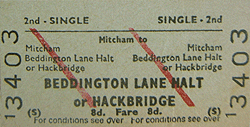
Although there were two or three patches of new housing between Morden Road and Mitcham by the end of the 1930s, the rural atmosphere was preserved when the extensive area of Morden Hall Park came under the care of the National Trust. From Mitcham to the Junction many small houses were built between 1927 and 1939 and the general residential growth of the Mitcham area required some improvement to the goods yard in 1936. At Beddington Lane there was a small cluster of new housing close to the station. The mixed land uses and street transport competition stunted the growth of passenger traffic that normally accompanied suburban electrification. The 2-car sets continued to provide ample accommodation for the traffic offering right through to the 1950s, when they reached the end of their useful life. In 1954 they gave way to BR 2EPB 2-car sets which brought an end to the conductor-guard operation and ticket issuing arrangements were provided at Morden Road while passengers using Waddon Marsh and Beddington Lane were able to buy tickets from the signalmen.
Freight traffic was still quite heavy in the mid 1950s but by the’ 60s this was in decline. Mitcham yard closed, from 1 May 1967. After the Croydon gasworks closed, there remained until 1973 two or three daily trips bringing coal from Betteshanger Colliery in Kent to Croydon B power station, but in that year a switch was made to Durham coal brought by coastal vessels to Kingsnorth (Kent) where it was loaded into lorry loads and taken over congested urban roads to Croydon. This left gas oil for the power station’s auxiliary plant as the only regular freight movement.
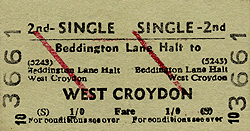
The W&CR was early on the list for closure, coming up for the first time in 1951 when it was decided that with freight still important, passenger abandonment did not make much sense, as signalling could not be much reduced so withdrawal of the passenger service would make little difference to operating costs. It is perhaps surprising that the Reshaping of British Railways (‘Beeching Report’) of March 1963 did not recommend the line for closure. However, there followed a series of economy cuts, starting with Sunday closure of Morden Road from 13 September 1964. From 20 June 1965 Sunday trains were withdrawn over the whole line and from 7 November 1966 Morden Road was also closed on Saturdays. This last date also saw curtailment of evening service with last trains brought back to around 7.45pm departures each end instead of 10.45pm. First trains now started at around 7.15am, but frequency remained half-hourly through the shorter day, still with some extras at peak hours (the last of these were eventually withdrawn in May 1971).
In common with others on the Southern Region, the halts lost this description in the timetables operative from 5 May 1969. With the drastic reduction in freight, it became possible to work the separate goods line between West Croydon and Beddington as a siding from West Croydon. In 1971 a land slip on the Wimbledon side of the road bridge at Mitcham station resulted in the double-track section being cut back to the station and the up platform was taken out of use. BR once again considered closure that year but despite declining passenger numbers there was strong opposition and the line was reprieved after a public enquiry.
A year later, BR issued a poster encouraging people to ‘ride the line, which remains a useful link between two important suburban centres’. However the April 1972 issue of Railway Magazine reported 'Notice has been given by the Southern Region that the withdrawal is planned of the passenger service between West Croydon and Wimbledon via Mitcham. This would involve complete closure of five intermediate stations.' The September 1974 issue reported that the line was 'one of six lines reprieved on 31 July 1974 by Fred Mulley, Secretary of State - should be covered by the first obligation to operate a passenger network which he would be imposing under Clause 3 of the Railway Bill which was to receive Royal Assent that same day.'
After October 1991 the last 'slam door' Class 416 units were withdrawn from the line which was then worked by modern air door Class 456 units.
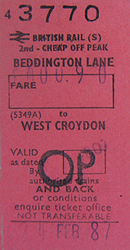 In 1986 a study was carried out by London Transport and British Rail which covered all of London. From 1990 Croydon Council and London Transport worked to promote a tram network to reduce traffic congestion. Public consultations took place during 1991 discussing routes and testing public opinion which resulted in a Bill being put before Parliament in November 1991. The Croydon Tramlink Act received Royal Assent on 21 July 1994 giving London Regional Transport the legal power to build and run 'Tramlink'. Three routes were planned, Route 1 running from Elmers End to Wimbledon utilising he entire length of the Wimbledon and West Croydon line. In 1986 a study was carried out by London Transport and British Rail which covered all of London. From 1990 Croydon Council and London Transport worked to promote a tram network to reduce traffic congestion. Public consultations took place during 1991 discussing routes and testing public opinion which resulted in a Bill being put before Parliament in November 1991. The Croydon Tramlink Act received Royal Assent on 21 July 1994 giving London Regional Transport the legal power to build and run 'Tramlink'. Three routes were planned, Route 1 running from Elmers End to Wimbledon utilising he entire length of the Wimbledon and West Croydon line.
By this time the line was in a very dilapidated state with little passenger traffic and all the stations covered in graffiti. Closure was announced for 2 June 1997 with a special service operating on 31 May to cope with the anticipated crowds. This shuttled backwards and forwards all day but even before closure most of the signage had been removed from the stations to deter theft by collectors, and the stations took on an air of desolation despite the crowded platforms. The final train was en enthusiasts’ 'special' which also travelled over the Elmers End - Addicombe branch which also closed on the same day as part of the Tramlink conversion.
Work on Tramlink had started in January 1997 and was scheduled to be complete for an opening in November 1999. Initially little work was done on the Wimbledon - Croydon line but the track was lifted in the summer of 1998 followed by the demolition of all the stations with the exception of the 'up' platform and original station building at Mitcham and the station building at Merton Park. All the stations were retained as stops on Tramlink with new platforms with the exception of Waddon Marsh where a new site was selected several hundred yards closer to Croydon.
A variety of problems with the contractors and numerous legal contracts delayed the opening of the new line. The first tram was delivered in October 1998 to the new depot at Therapia Lane and testing on sections of the Wimbledon line began shortly afterwards. The first tram ran through streets of Croydon on 16 June 1999.
The official opening finally took place on 10 May 2000 at New Addington when Route 3 opened to the public. Route 2 to Beckenham Junction opened on 23 May 2000 with the Route 1 from Elmers End to Wimbledon opening a week later on 29 May 2000.
Tickets from Michael Stewart, Graham Larkbey & Brian Halford
Sources:
See other web sites: Transport
of Delight for more old pictures of the Wimbledon - West Croydon line and the Unofficial Croydon Tramlink web site
Click on station name for other stations on the Wimbledon - West Croydon line: Merton Park, Morden Road, Mitcham, Mitcham Junction, Waddon Marsh
& West Croydon
See also the Tooting Merton & Wimbledon Railway: Merton Abbey, Tooting Junction & Haydons Road.
See also the St. Helier Estate Railway
(West Croydon, Mitcham Junction and Haydons Road are still open but are included for completeness) |

halt_old14.jpg)

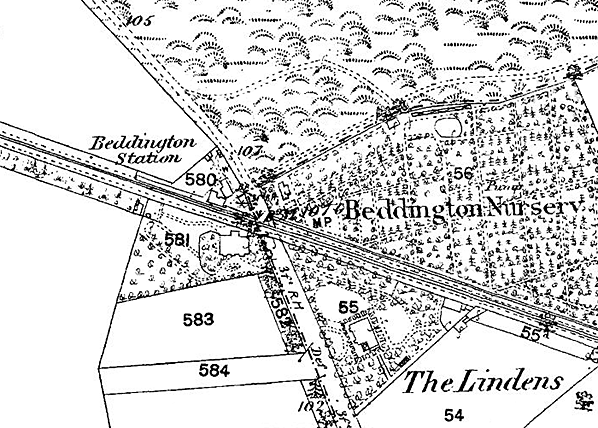 1876 1:2,500 OS Map shows Beddington station in its original form, 21 years after the station opened. The station building is seen with another unidentified building, perhaps the original stationmaster's house, immediately behind it. The area around the station was very rural at this time with the Beddington Nursery on the east side of Beddington Lane. There is a large house opposite the station and another, The Lindens, on the east side of Beddington Lane.
1876 1:2,500 OS Map shows Beddington station in its original form, 21 years after the station opened. The station building is seen with another unidentified building, perhaps the original stationmaster's house, immediately behind it. The area around the station was very rural at this time with the Beddington Nursery on the east side of Beddington Lane. There is a large house opposite the station and another, The Lindens, on the east side of Beddington Lane.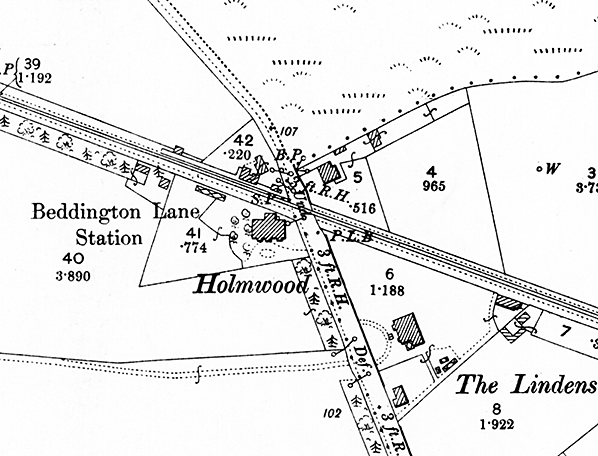
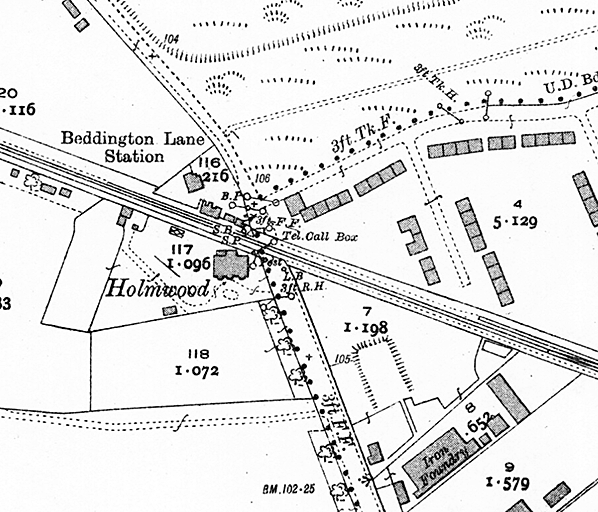
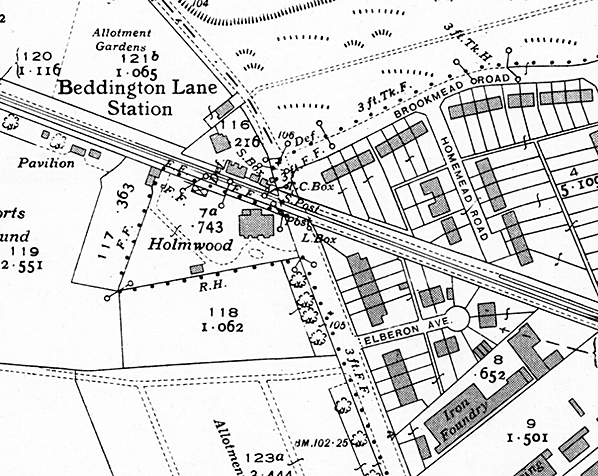
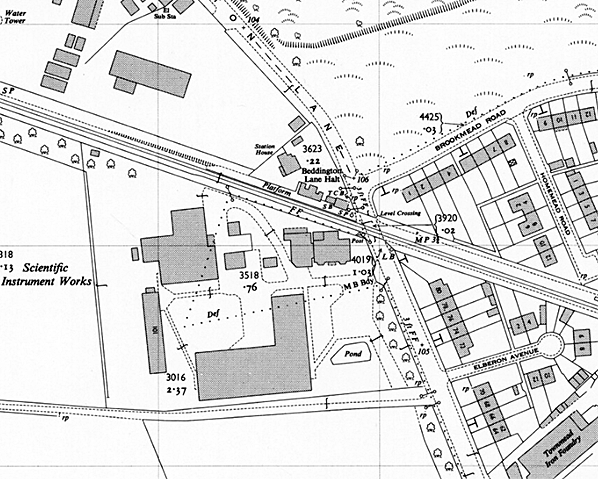
halt_old5.jpg)
halt_old8.jpg)
halt_old7.jpg)
 Home Page
Home Page 
 The original box was replaced by a larger timber structure on a brick base on 25 May 1930. As with the box at Waddon Marsh, this doubled-up as the ticket office for some time; tickets could also be bought from the guard. Beddington Lane Halt received BR totem signage in standard Gill Sans and a running-in board letters in Transport typeface. David Lawrence in British Rail Designed 1948-97 (Ian Allan, 2016) notes that ‘the Transport alphabet designed for British motorway signs by Jock Kinneir and Margaret Calvert was offered to British Railways too, resulting in its use on some totem and other signs in the late 1950s’, but its use appears to have been a uniquely Southern Region aberration. Gas lighting gave way to electric sometime between 1962 and 1967. The station reverted to Beddington Lane on 6 May 1969, when BR (SR) discontinued using the ‘Halt’ suffix for public stations, although all the station signs still showed Beddington Lane Halt until Corporate Identity signage was installed at some date between 22 December 1978 and 19 February 1979. The independent freight line between Beddington Lane and West Croydon was taken out of use from 1 February 1976 and from 14 September 1980 the signal box was only used to work the crossing gates. When the gates were replaced by automatic lifting barriers on 23 May 1982 the box was closed and it was demolished shortly afterwards. The wooden station building was demolished in the 1990s and replaced with a ‘bus’ shelter.
The original box was replaced by a larger timber structure on a brick base on 25 May 1930. As with the box at Waddon Marsh, this doubled-up as the ticket office for some time; tickets could also be bought from the guard. Beddington Lane Halt received BR totem signage in standard Gill Sans and a running-in board letters in Transport typeface. David Lawrence in British Rail Designed 1948-97 (Ian Allan, 2016) notes that ‘the Transport alphabet designed for British motorway signs by Jock Kinneir and Margaret Calvert was offered to British Railways too, resulting in its use on some totem and other signs in the late 1950s’, but its use appears to have been a uniquely Southern Region aberration. Gas lighting gave way to electric sometime between 1962 and 1967. The station reverted to Beddington Lane on 6 May 1969, when BR (SR) discontinued using the ‘Halt’ suffix for public stations, although all the station signs still showed Beddington Lane Halt until Corporate Identity signage was installed at some date between 22 December 1978 and 19 February 1979. The independent freight line between Beddington Lane and West Croydon was taken out of use from 1 February 1976 and from 14 September 1980 the signal box was only used to work the crossing gates. When the gates were replaced by automatic lifting barriers on 23 May 1982 the box was closed and it was demolished shortly afterwards. The wooden station building was demolished in the 1990s and replaced with a ‘bus’ shelter.  The line was never profitable as much of the traffic from Croydon used the Croydon Canal which opened in 1809 terminating at a basin adjacent to the Surrey Iron Railway at what is now West Croydon station. After 1825 the company paid no dividend. Early in 1844 there was a proposal by the London & Brighton to use the former trackbed of the Surrey Iron Railway and the CM&GR to reach a new terminus at Waterloo Bridge from its existing Brighton line at Purley, and in August that year the London & South Western Railway took an option to buy the SIR track bed but neither scheme was proceeded with and the SIR was eventually dissolved on 3 August 1846 and the track bed reverted to agricultural use.
The line was never profitable as much of the traffic from Croydon used the Croydon Canal which opened in 1809 terminating at a basin adjacent to the Surrey Iron Railway at what is now West Croydon station. After 1825 the company paid no dividend. Early in 1844 there was a proposal by the London & Brighton to use the former trackbed of the Surrey Iron Railway and the CM&GR to reach a new terminus at Waterloo Bridge from its existing Brighton line at Purley, and in August that year the London & South Western Railway took an option to buy the SIR track bed but neither scheme was proceeded with and the SIR was eventually dissolved on 3 August 1846 and the track bed reverted to agricultural use. 

 On 1 October 1868, the LBSCR opened their line from Peckham Rye to Sutton; this cut across Mitcham Common turning sharply to join the W&CR where a new shared station at Mitcham Junction was opened. Beyond the station the new line diverged to the south and on towards Sutton.
On 1 October 1868, the LBSCR opened their line from Peckham Rye to Sutton; this cut across Mitcham Common turning sharply to join the W&CR where a new shared station at Mitcham Junction was opened. Beyond the station the new line diverged to the south and on towards Sutton. 
 With the opening of the Northern Line extension to Morden on 13 September 1926 passenger revenue form Merton Park, Morden Road (formerly Morden) and Mitcham declined rapidly although through journeys continued to attract a steady patronage. In 1927 there were 14 push-and-pull workings between Wimbledon and West Croydon, one extended to Crystal Palace Low Level, two from Wimbledon to Sutton via Mitcham Junction, and another from Mitcham to Crystal Palace Low Level; a similar service worked down. The line maintained healthy freight traffic, especially around Croydon and Waddon Marsh. In 1930, during the building of the London County Council's 825-acre St Helier housing estate, the contractors laid an extensive temporary network of flat-bottom rails on cinder ballast to carry materials as required to the building sites, this being connected to the W&CR through a siding at Mitcham goods yard. This rail network which included a 30ft bridge over the River Wandle was operated by six locomotives shedded at a depot about a mile south of Mitcham. It was one of the last examples in southern England of a major public works contract relying on rail-delivered materials which were carried to site over specially-laid lines. The W&CR also handled the Southern’s own needs for its permanent way depot on the north side of the line near Beddington Lane and for the civil engineer’s depot next to the goods yard at Mitcham.
With the opening of the Northern Line extension to Morden on 13 September 1926 passenger revenue form Merton Park, Morden Road (formerly Morden) and Mitcham declined rapidly although through journeys continued to attract a steady patronage. In 1927 there were 14 push-and-pull workings between Wimbledon and West Croydon, one extended to Crystal Palace Low Level, two from Wimbledon to Sutton via Mitcham Junction, and another from Mitcham to Crystal Palace Low Level; a similar service worked down. The line maintained healthy freight traffic, especially around Croydon and Waddon Marsh. In 1930, during the building of the London County Council's 825-acre St Helier housing estate, the contractors laid an extensive temporary network of flat-bottom rails on cinder ballast to carry materials as required to the building sites, this being connected to the W&CR through a siding at Mitcham goods yard. This rail network which included a 30ft bridge over the River Wandle was operated by six locomotives shedded at a depot about a mile south of Mitcham. It was one of the last examples in southern England of a major public works contract relying on rail-delivered materials which were carried to site over specially-laid lines. The W&CR also handled the Southern’s own needs for its permanent way depot on the north side of the line near Beddington Lane and for the civil engineer’s depot next to the goods yard at Mitcham.


 In 1986 a study was carried out by London Transport and British Rail which covered all of London. From 1990 Croydon Council and London Transport worked to promote a tram network to reduce traffic congestion. Public consultations took place during 1991 discussing routes and testing public opinion which resulted in a Bill being put before Parliament in November 1991. The Croydon Tramlink Act received Royal Assent on 21 July 1994 giving London Regional Transport the legal power to build and run 'Tramlink'. Three routes were planned, Route 1 running from Elmers End to Wimbledon utilising he entire length of the Wimbledon and West Croydon line.
In 1986 a study was carried out by London Transport and British Rail which covered all of London. From 1990 Croydon Council and London Transport worked to promote a tram network to reduce traffic congestion. Public consultations took place during 1991 discussing routes and testing public opinion which resulted in a Bill being put before Parliament in November 1991. The Croydon Tramlink Act received Royal Assent on 21 July 1994 giving London Regional Transport the legal power to build and run 'Tramlink'. Three routes were planned, Route 1 running from Elmers End to Wimbledon utilising he entire length of the Wimbledon and West Croydon line.
